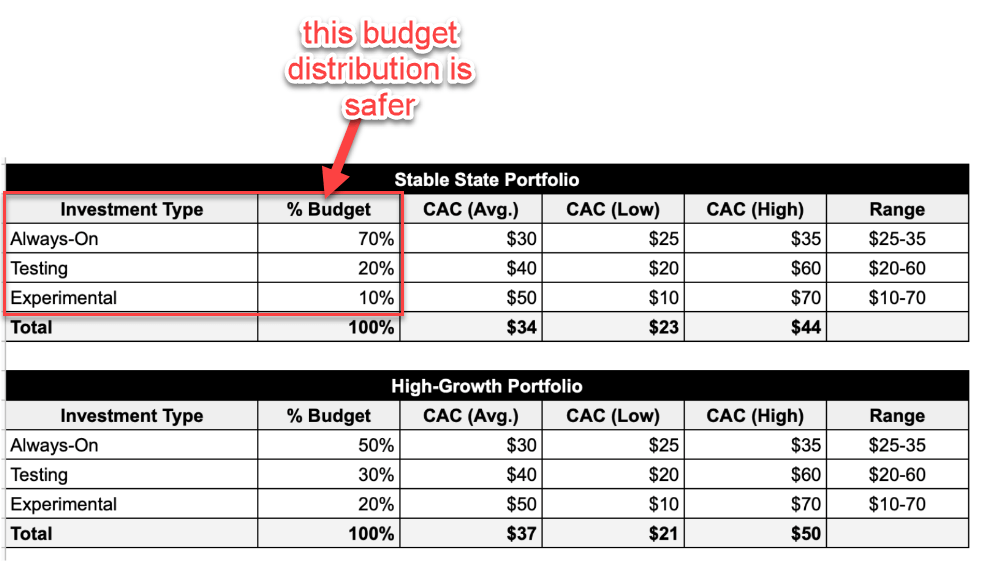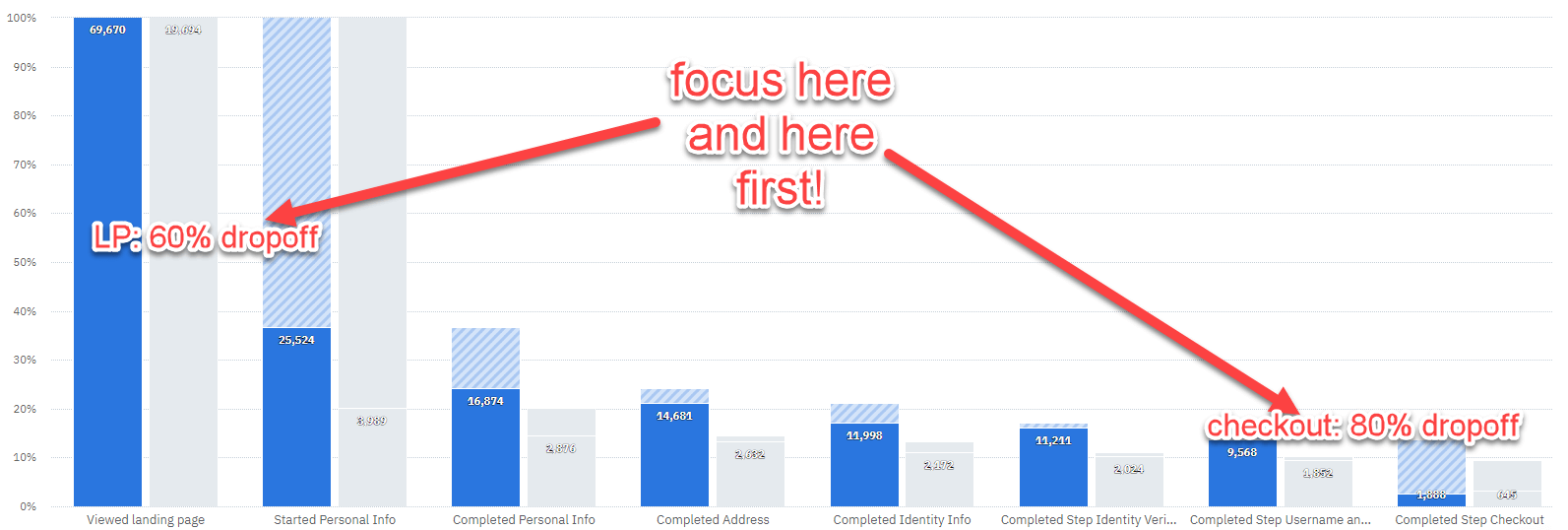Dave Riggs is an engineer turned growth marketer and the co-founder of Apex Growth, a growth marketing agency that provides management consulting to senior growth leaders and marketing support. Previously, Dave worked in Growth for FoxNext Games, Snap, Ring.com, and Pluto TV.
We’re in a recession, so how should you respond? Here are 3 proven strategies to focus on.
Inflation concerns are growing worldwide, and they’re impacting company valuations. That said, it’s likely that growth expectations remain the same at your company.
Your CEO or CFO may anticipate that growth will slow due to macroeconomic factors, but they may also plan to cut costs to improve profitability. Taken together, their growth expectations will likely stay the same. They may even be more vocal about growing the business in tough market conditions.
The good news is there are tried and tested growth strategies that work both during a recession and periods of high growth. If you stay hyper-focused on your KPIs, you will be more able to weather the storm and emerge stronger in years to come.
Here are three areas you should be focusing on now:
1. Simplify your Marketing Investments and Improve Focus (Do Fewer Things Better)
Almost every paid marketing campaign setup is more complicated than it should be. When we took over UA for a streaming company spending $4-5M/month, they had eight different networks running with 50+ campaigns. Managing the campaign setups and creatives was far too difficult to do properly.
We used this prioritization framework to decide what to keep and what to cut:
- Is this campaign meeting or coming close to performance targets?
- If not, can we reach targets within a 2-3 week period?
- Is this strategic for the business to continue running?
We answered no about two-thirds of the time. You’ll likely answer no for at least half your campaigns.
In the first month, we shut off five of the eight networks that didn’t meet our criteria. We narrowed the campaigns on the remaining three networks to under 10, largely by consolidation. For example, we shifted all Facebook interest and lookalike targeted campaigns into broad campaigns for each operating system. On Google UAC, we ran only one campaign per geo and OS instead of running multiple experimental campaigns with different optimization and bidding settings.
While we consolidated, we limited all experimentation for about a month to let the ad platform algorithms re-learn and settle with new spend levels and campaign setups. Having fewer campaigns also enabled us to go deeper into creative strategy and optimization, enabling us to focus and improve creative performance dramatically.
This new “Stable State Portfolio” performed over 50% better than its previous iteration. This was primarily due to providing the algorithms with fewer, simpler campaign structures with larger audiences.

Takeaway: Almost always, a single broad-targeted campaign will work better than several more narrowly-targeted campaigns. Run fewer networks and campaigns and go deeper on creative. Simplify and you’re likely to see increased performance and have more time to focus on analysis.
2. Shift Resources to Conversion Optimization Activities
As the great venture capitalist Bill Gurley says, conversion is the most important internet metric of all. The thesis is this: if a company obsesses about only one metric, it should be conversion.
The reason is that any increase in conversion has a dramatic, potentially game-changing effect on UA. If you increase your conversion rate 20%, your CPA drops 20%. You can spend more money on Google and Facebook, potentially increasing your CTR and quality score, lowering costs even further. Conversion improvements have a quadratic effect.
In the thousands of AB tests my co-founder David Mausolf and I have run at Experian, Lyft, Disney, and at our agency Apex, we’ve never found a correlation between the amount of dev effort and increases in conversions.
In other words, more engineering effort for AB testing doesn’t generally lead to a higher conversion rate. You should be running fewer, smaller experiments and doing them more frequently. For each experiment you design, ask yourself, “how can I de-scope this to do it in half the time?” In two days, you’ll be more successful running four experiments that take a half-day each to deploy instead of two experiments that each take a day to run.
So, where do you come up with experiment ideas?
First off, let the data inform your area of focus. Below is one of our conversion funnels for a credit monitoring site for which we spend $500k/month in SEM. The largest drop-offs occur on the landing page (60% dropoff) and checkout (80% dropoff). Every other step is relatively negligible.

Each additional 10% conversion increase widens the funnel considerably and makes a meaningful difference in CPA. Another added benefit is that the more conversion data we feed Google, the smarter the algorithm is in finding future conversions. We can also spend more, which gives us higher rankings in SEM, which leads to increased CTR. This leads to an improved quality score, which further lowers CPC costs, improving CPA.
Once you’ve defined what areas of the funnel to focus on, source your experiment ideas from a wide variety of people. This should include everyone from the CEO to the intern. Most of the time those who are less familiar with a particular product or service are able to come up with more unique ideas that move the needle. Once you source the ideas, use the ICE framework to prioritize, then execute.
Takeaway: Dedicate resources from product or engineering to conversion optimization. Conversion increases stretch paid marketing dollars much further. Flat or static budgets become more effective over time. You will generate more conversions for the same amount of money.
3. Create Alignment with your CFO and/or Finance Team
It’s common for marketers and finance teams to be looking at different reports. Marketers typically look at 3rd party ad network dashboards (or Google Sheets) for reporting. Finance usually leverages BI tools like Looker or Tableau. These reporting siloes often create two different stories about how the marketing team is actually performing.
For example, Google or Facebook-reported conversions and CPA (which the ad networks use to optimize) do not always match database-reported transactions.
To solve this problem, we created a platform Alpha.io to solve for standardizing reporting for marketers and finance teams. For our clients, everyone including marketers, analysts, and even executives log into this first every morning, ensuring full alignment on business performance.
However, before you go down the route of building an entirely new reporting infrastructure, ask your finance team “what reports are you looking at every day?” Do you understand each finance KPI and can you tie them directly to your marketing KPIs? Specifically, compare the transactions and revenue that your marketing reports are showing against finance reports. Work on aligning them as much as possible—either by cleaning up conversion tracking, adding a multiplier to your conversions, or (ideally) pulling finance numbers into your marketing reporting.
Next, start to build a weekly operational cadence with your finance team and/or your leadership team to review targets and improve profitability. Use a single view or dashboard that all teams can understand. Make sure everyone is using the same set of reports and data. You’ll still use your ad platform data to optimize campaigns outside of meetings, but you’ll use this view when justifying and reporting on marketing performance in groups.

Takeaway: Become BFFs with your finance team. Meet with them regularly. Make sure you speak the same language and review the same KPIs. This alignment may increase your autonomy and generate a quicker “yes” when you need to increase your budget for paid marketing.
Whether you're trying to grow your business, go international, or enter new business lines, having the right 3Ps (People, Processes, Plans) is critical. Reach out to Apex if you're looking for a partner to help set up similar growth systems and take your business to the next level.
